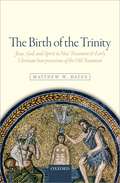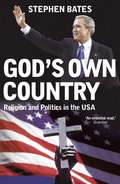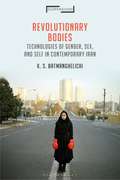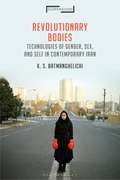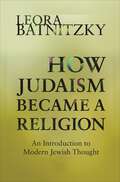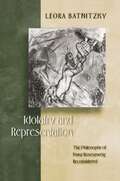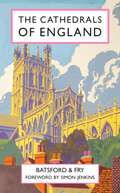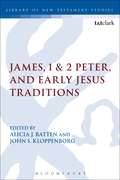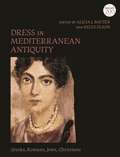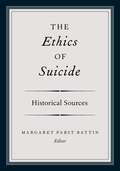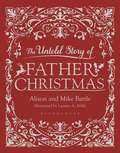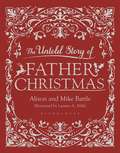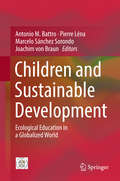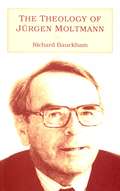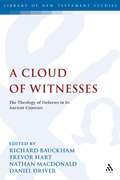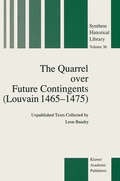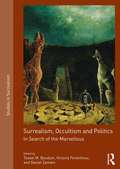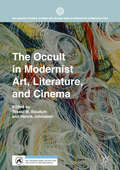- Table View
- List View
The Birth of the Trinity: Jesus, God, and Spirit in New Testament and Early Christian Interpretations of the Old Testament
by Matthew W. BatesHow and when did Jesus and the Spirit come to be regarded as fully God? The Birth of the Trinity offers a new historical approach by exploring the way in which first- and second-century Christians read the Old Testament in order to differentiate the one God as multiple persons. The earliest Christians felt they could metaphorically overhear divine conversations between the Father, Son, and Spirit when reading the Old Testament. When these snatches of dialogue are connected and joined, they form a narrative about the unfolding interior divine life as understood by the nascent church. What emerges is not a static portrait of the triune God, but a developing story of divine persons enacting mutual esteem, voiced praise, collaborative strategy, and self-sacrificial love. The presence of divine dialogue in the New Testament and early Christian literature shows that, contrary to the claims of James Dunn and Bart Ehrman (among others), the earliest Christology was the highest Christology, as Jesus was identified as a divine person through Old Testament interpretation. The result is a Trinitarian biblical and early Christian theology.
God's Own Country: Religion and Politics in the USA
by Stephen BatesRight-wing evangelical Christianity has come to dominate American political and social life in recent years, dividing the country and sparking cultural and moral battles. High politics and low tactics frame a fierce debate which goes much further back in the country's history than the accession of George W. Bush in 2001. It's a battle that sears America's soul and affects the world. In this book Stephen Bates explains why what happens in the Bible Belt matters to us and how there are those who hope to export the battle to Britain. American fundamentalist religion has the potential to impact on crucial and acutely dangerous areas of the world. Its priorities are often arcane and sometimes weird. But it is already affecting American government policy at home and abroad: not least in Israel and the Middle East. How is religion affecting the current presidential elections and where will America's battle for its soul take the world next?
Revolutionary Bodies: Technologies of Gender, Sex, and Self in Contemporary Iran (Suspensions: Contemporary Middle Eastern and Islamicate Thought)
by K. S. BatmanghelichiGender and sexuality in modern Iran is frequently examined through the prism of nationalist symbols and religious discourse from the late nineteenth and early twentieth centuries. In this book, Kristin Soraya Batmanghelichi takes a different approach, by interrogating how normative ideas of women's bodies in state, religious, and public health discourses have resulted in the female body being deemed as immodest and taboo. Through a diverse blend of sources -a popular cultural women's journal, a red-light district, cases studies of temporary marriages, iconic public statues, and an HIV-AIDS advocacy organization in Tehran - this work argues that conceptions of gender and sexuality have been mediated in public discourse and experienced and modified by women themselves over the past thirty years of the Islamic Republic.Expanding upon existing philosophical theory, technological research and scholarship on gender and sexuality in Iran, this book focuses much needed attention on under-studied, marginalized communities, such as widows living with HIV. This work interrogates how bodily technologies are constructed discursively and socially in Iran and the values and perspectives which are incorporated in them.
Revolutionary Bodies: Technologies of Gender, Sex, and Self in Contemporary Iran (Suspensions: Contemporary Middle Eastern and Islamicate Thought)
by K. S. BatmanghelichiGender and sexuality in modern Iran is frequently examined through the prism of nationalist symbols and religious discourse from the late nineteenth and early twentieth centuries. In this book, Kristin Soraya Batmanghelichi takes a different approach, by interrogating how normative ideas of women's bodies in state, religious, and public health discourses have resulted in the female body being deemed as immodest and taboo. Through a diverse blend of sources -a popular cultural women's journal, a red-light district, cases studies of temporary marriages, iconic public statues, and an HIV-AIDS advocacy organization in Tehran - this work argues that conceptions of gender and sexuality have been mediated in public discourse and experienced and modified by women themselves over the past thirty years of the Islamic Republic.Expanding upon existing philosophical theory, technological research and scholarship on gender and sexuality in Iran, this book focuses much needed attention on under-studied, marginalized communities, such as widows living with HIV. This work interrogates how bodily technologies are constructed discursively and socially in Iran and the values and perspectives which are incorporated in them.
How Judaism Became a Religion: An Introduction to Modern Jewish Thought
by Leora BatnitzkyIs Judaism a religion, a culture, a nationality--or a mixture of all of these? In How Judaism Became a Religion, Leora Batnitzky boldly argues that this question more than any other has driven modern Jewish thought since the eighteenth century. This wide-ranging and lucid introduction tells the story of how Judaism came to be defined as a religion in the modern period--and why Jewish thinkers have fought as well as championed this idea. Ever since the Enlightenment, Jewish thinkers have debated whether and how Judaism--largely a religion of practice and public adherence to law--can fit into a modern, Protestant conception of religion as an individual and private matter of belief or faith. Batnitzky makes the novel argument that it is this clash between the modern category of religion and Judaism that is responsible for much of the creative tension in modern Jewish thought. Tracing how the idea of Jewish religion has been defended and resisted from the eighteenth century to today, the book discusses many of the major Jewish thinkers of the past three centuries, including Moses Mendelssohn, Abraham Geiger, Hermann Cohen, Martin Buber, Zvi Yehuda Kook, Theodor Herzl, and Mordecai Kaplan. At the same time, it tells the story of modern orthodoxy, the German-Jewish renaissance, Jewish religion after the Holocaust, the emergence of the Jewish individual, the birth of Jewish nationalism, and Jewish religion in America. More than an introduction, How Judaism Became a Religion presents a compelling new perspective on the history of modern Jewish thought.
How Judaism Became a Religion: An Introduction to Modern Jewish Thought
by Leora BatnitzkyIs Judaism a religion, a culture, a nationality--or a mixture of all of these? In How Judaism Became a Religion, Leora Batnitzky boldly argues that this question more than any other has driven modern Jewish thought since the eighteenth century. This wide-ranging and lucid introduction tells the story of how Judaism came to be defined as a religion in the modern period--and why Jewish thinkers have fought as well as championed this idea. Ever since the Enlightenment, Jewish thinkers have debated whether and how Judaism--largely a religion of practice and public adherence to law--can fit into a modern, Protestant conception of religion as an individual and private matter of belief or faith. Batnitzky makes the novel argument that it is this clash between the modern category of religion and Judaism that is responsible for much of the creative tension in modern Jewish thought. Tracing how the idea of Jewish religion has been defended and resisted from the eighteenth century to today, the book discusses many of the major Jewish thinkers of the past three centuries, including Moses Mendelssohn, Abraham Geiger, Hermann Cohen, Martin Buber, Zvi Yehuda Kook, Theodor Herzl, and Mordecai Kaplan. At the same time, it tells the story of modern orthodoxy, the German-Jewish renaissance, Jewish religion after the Holocaust, the emergence of the Jewish individual, the birth of Jewish nationalism, and Jewish religion in America. More than an introduction, How Judaism Became a Religion presents a compelling new perspective on the history of modern Jewish thought.
Idolatry and Representation: The Philosophy of Franz Rosenzweig Reconsidered
by Leora BatnitzkyAlthough Franz Rosenzweig is arguably the most important Jewish philosopher of the twentieth century, his thought remains little understood. Here, Leora Batnitzky argues that Rosenzweig's redirection of German-Jewish ethical monotheism anticipates and challenges contemporary trends in religious studies, ethics, philosophy, anthropology, theology, and biblical studies. This text, which captures the hermeneutical movement of Rosenzweig's corpus, is the first to consider the full import of the cultural criticism articulated in his writings on the modern meanings of art, language, ethics, and national identity. In the process, the book solves significant conundrums about Rosenzweig's relation to German idealism, to other major Jewish thinkers, to Jewish political life, and to Christianity, and brings Rosenzweig into conversation with key contemporary thinkers. Drawing on Rosenzweig's view that Judaism's ban on idolatry is the crucial intellectual and spiritual resource available to respond to the social implications of human finitude, Batnitzky interrogates idolatry as a modern possibility. Her analysis speaks not only to the question of Judaism's relationship to modernity (and vice versa), but also to the generic question of the present's relationship to the past--a subject of great importance to anyone contemplating the modern statuses of religious tradition, reason, science, and historical inquiry. By way of Rosenzweig, Batnitzky argues that contemporary philosophers and ethicists must relearn their approaches to religious traditions and texts to address today's central ethical problems.
Idolatry and Representation: The Philosophy of Franz Rosenzweig Reconsidered
by Leora BatnitzkyAlthough Franz Rosenzweig is arguably the most important Jewish philosopher of the twentieth century, his thought remains little understood. Here, Leora Batnitzky argues that Rosenzweig's redirection of German-Jewish ethical monotheism anticipates and challenges contemporary trends in religious studies, ethics, philosophy, anthropology, theology, and biblical studies. This text, which captures the hermeneutical movement of Rosenzweig's corpus, is the first to consider the full import of the cultural criticism articulated in his writings on the modern meanings of art, language, ethics, and national identity. In the process, the book solves significant conundrums about Rosenzweig's relation to German idealism, to other major Jewish thinkers, to Jewish political life, and to Christianity, and brings Rosenzweig into conversation with key contemporary thinkers. Drawing on Rosenzweig's view that Judaism's ban on idolatry is the crucial intellectual and spiritual resource available to respond to the social implications of human finitude, Batnitzky interrogates idolatry as a modern possibility. Her analysis speaks not only to the question of Judaism's relationship to modernity (and vice versa), but also to the generic question of the present's relationship to the past--a subject of great importance to anyone contemplating the modern statuses of religious tradition, reason, science, and historical inquiry. By way of Rosenzweig, Batnitzky argues that contemporary philosophers and ethicists must relearn their approaches to religious traditions and texts to address today's central ethical problems.
Creativity and Taoism: A Study of Chinese Philosophy, Art and Poetry
by Zhao Xian Batt Chung-Yuan Chang'In Creativity and Taoism, Chang Chung-yuan makes the elusive principle of Tao available to the western mind with objectivity, warmth, and depth of insight. It is an important contribution to the task of making the Taoist wisdom accessible to the western intellect' - Ira Progoff 'No one can read Chang's book without experiencing a broadening of his mental horizons' - John C. H. Wu, Philosophy East and West 'His interpretation of the Taoist roots of Ch'an has been presented with taste and learning that help to clear up many questions that must have occurred to anyone familiar with his subject. "The Spirit of the Valley" dwells in this quiet and gentle man who, as so rarely happens, actually embodies some of the philosophic traits of which he writes' - Gerald Sykes 'If the end of reading is the enhancement of life, the enlargement of experience and understanding, then this book becomes an important step in that direction. Dr. Chang writes in a style both lucid and felicitous. He displays with becoming modesty a mastery of the field, its development and its ideas... There is hardly a page which does not give pleasure' - Robert R. Kirsh, Los Angeles Times 'Professor Chang's study, a brilliant exposition and analysis, is concerned with the relevance and applicability of the Taoist view in Chinese artistic and intellectual creativity. Few other works facilitate so sensitive an understanding of creative impulse and expression in Chinese culture' - Hyman Kublin, Library Journal Simultaneously accessible and scholarly, this classic book considers the underlying philosophy and the aesthetics of Chinese art and poetry, the expression of the Taoist approach to existence. Chapters cover everything from the potential of creativity to the way tranquillity is reflected in Chinese poems and painting. Chung-yuan Chang's deceptively simple and always lucid narrative explores the relationship between the Tao and the creative arts, introducing classic paintings and poems to bring Taoism to life.
James, 1 & 2 Peter, and Early Jesus Traditions (The Library of New Testament Studies #478)
by Alicia J. Batten John S. KloppenborgThis book studies comparisons and possible trajectories between three 'catholic' epistles: James, 1 and 2 Peter, and traditions associated with Jesus. It covers a range of approaches, exploring the extent to which these letters 'allude' to Jesus' teachings, how they share similar themes, and how and why the letters recall specific memories of the figure of Jesus as found in the Gospels or in Pauline traditions. Studies have argued that James has alluded to some of the sayings attributed to Jesus, but there is no consensus as to what extent or why. Part A analyzes why James would 'allude' to the teachings of Jesus, how he alters these teachings, and what such adaptations suggests about his audience. Part B turns to the Jesus tradition and 1 and 2 Peter. What can 1 Peter's use of Isaiah 53 tell us about the historical Jesus? How has 1 Peter conflated early Jesus traditions with those of ancient Judaism in order to develop certain ideas? How does 2 Peter allude to Gospel traditions? Moreover, how does the author of 2 Peter use early Jesus traditions as a sort of testimony?  The book is important in assisting scholarly thought about source criticism, ancient rhetoric, the influence of Hellenistic, Judean and Roman traditions on early Christianity, and its social history in general.
Dress in Mediterranean Antiquity: Greeks, Romans, Jews, Christians
by Alicia J. Batten Kelly OlsonInsights from anthropology, religious studies, biblical studies, sociology, classics, and Jewish studies are here combined to provide a cutting-edge guide to dress and religion in the Greco-Roman World and the Mediterranean basin. Clothing, jewellery, cosmetics, and hairstyles are among the many aspects examined to show the variety of functions of dress in communication and in both establishing and defending identity. The volume begins by reviewing how scholars in the fields of classics, anthropology, religious studies, and sociology examine dress. The second section then looks at materials, including depictions of clothing in sculpture and in Egyptian mummy portraits. The third (and largest) part of the book then examines dress in specific contexts, beginning with Greece and Rome and going on to Jewish and Christian dress, with a specific focus on the intersection between dress, clothing and religion. By combining essays from over twenty scholars from different disciplinary backgrounds, the book provides a unique overview of different approaches to and contexts of dress in one volume, leading to a greater understanding of dress both within ancient societies and in the contemporary world.
ETHICS OF SUICIDE C: Historical Sources
by Margaret Pabst BattinIs suicide wrong, profoundly morally wrong? Almost always wrong, but excusable in a few cases? Sometimes morally permissible? Imprudent, but not wrong? Is it sick, a matter of mental illness? Is it a private matter or a largely social one? Could it sometimes be right, or a "noble duty," or even a fundamental human right? Whether it is called "suicide" or not, what role may a person play in the end of his or her own life? This collection of primary sources--the principal texts of ethical interest from major writers in western and nonwestern cultures, from the principal religious traditions, and from oral cultures where observer reports of traditional practices are available, spanning Europe, Asia, the Middle East, Africa, Oceania, the Arctic, and North and South America--facilitates exploration of many controversial practical issues: physician-assisted suicide or aid-in-dying; suicide in social or political protest; self-sacrifice and martyrdom; suicides of honor or loyalty; religious and ritual practices that lead to death, including sati or widow-burning, hara-kiri, and sallekhana, or fasting unto death; and suicide bombings, kamikaze missions, jihad, and other tactical and military suicides. This collection has no interest in taking sides in controversies about the ethics of suicide; rather, rather, it serves to expand the character of these debates, by showing them to be multi-dimensional, a complex and vital part of human ethical thought.
The Untold Story of Father Christmas
by Alison Battle Mike Battle Lauren A. MillsHave you ever wondered where Father Christmas came from? And how he ended up with a factory at the North Pole full of elves to help him make toys? A beautifully illustrated and timeless story about how a toymaker and his wife became Mother and Father Christmas for children all over the world.
The Untold Story of Father Christmas
by Alison Battle Mike Battle Lauren A. MillsHave you ever wondered where Father Christmas came from? And how he ended up with a factory at the North Pole full of elves to help him make toys? A beautifully illustrated and timeless story about how a toymaker and his wife became Mother and Father Christmas for children all over the world.
Children and Sustainable Development: Ecological Education in a Globalized World
by Antonio M. Battro Pierre Léna Marcelo Sánchez Sorondo Joachim Von BraunThis book addresses the changes in education practices, especially basic education, necessitated by the global challenges of climate change and sustainable development and in a context characterized by increasing poverty and inequality, migration and refugees. Written by a range of international scholars, scientists and grassroots practitioners from Africa, Latin America, Asia (India, China, Malaysia) and Europe, the individual contributions focus on education policies and child development in various social contexts. Case-based experiences from both developed and developing countries provide inspiration and shed new light on the fundamental changes needed to adapt existing school systems and teacher training to face the challenges of the future. In this regard, the need to empower children themselves is emphasized.All contributions are based on a Workshop hosted in November 2015 by the Pontifical Academy of Sciences at the Vatican entitled “Children and Sustainable Development: A Challenge for Education” and follow three other significant events on sustainable development in 2015, namely the publication of Laudato Si’, the Encyclical Letter from Pope Francis, the release of the United Nations Sustainable Development Goals, and the COP21 Conference in Paris.
Climax of Prophecy: Studies on the Book of Revelation
by Richard BauckhamThe Apocalypse of John is a work of immense importance and learning. Yet among the major works of early Christianity included in the New Testament it has received relatively little scholarly attention.This work is a significant contribution to remedying this neglect. The author examines the meticulous literary artistry, creative imagination, radical political critique and profound theology of the Apocalypse of John. It is a sustained enterprise to understand both the form and the message of the Apocalypse in its literary and historical contexts.An invaluable and illuminating work for students, scholars and ministers
Jude and the Relatives of Jesus in the Early Church (Bloomsbury Academic Collections: Biblical Studies)
by Richard BauckhamThis volume is an original and important contribution to the study of the earliest Palestinian Jewish Christianity. For the first time all the evidence for the role which relatives of Jesus played in the early church is assembled and assessed. Dr. Bauckham discusses a wide range of evidence, not only from the New Testament but also from the Church Fathers, the New Testament Apocrypha, rabbinic literature and Palestinian archaeology. The letter of Jude, in particular, proves to have much to teach us about the theology of the brothers of Jesus and their circle. It illuminates their exegetical methods and their Christology and shows both to have been influential contributions to the development of early Christianity.This study shows that this neglected New Testament book is far more important for the study of early Christianity than has hitherto been recognized. By setting the letter of Jude within the context of the evidence for the role of relatives of Jesus in the early church, new insights can be revealed into the letter and early Jewish Christianity.
Theology of Jürgen Moltmann
by Richard BauckhamThe most comprehensive study available of one of the most influential of German Protestant theologians.
A Cloud of Witnesses: The Theology of Hebrews in its Ancient Contexts (The Library of New Testament Studies #387)
by Richard Bauckham Daniel Driver Trevor Hart Nathan MacDonaldThe book of Hebrews has often been the Cinderella of the New Testament, overlooked and marginalized; and yet it is one of the most interesting and theologically significant books in the New Testament. A Cloud of Witness examines the theology of the book in the light of its ancient historical context. There are chapters devoted to the structure of Hebrews, the person of Jesus Christ, Hebrews within the context of Second Temple Judaism and the Greco-Roman empire and the role of Hebrews in early Christian thought.
The Quarrel over Future Contingents: Unpublished Texts Collected by Leon Baudry (Synthese Historical Library #36)
by Leon BaudryThe Latin texts collected by Leon Baudry present the late fifteenth century debate at the University of Louvain over the truth-value of proposi tions about future contingent events, a subject of perennial interest in phil osophy. The theologians held fast to divine predetermination, and the Aristotelians in the Arts Faculty supported the doctrine of free choice based on indeterminism. Although the issues in the debate are still argued in philosophy, this rich collection of the theories and arguments has been neglected. Peter de Rivo and Henry de Zomeren, the principal antagonists, are cited in the recent literature, but only on the basis of slight, mostly second-hand information. The full collection of texts has never before been translated into English (or any other modern language), leaving them inaccessible to the majority of students, or any others who are not equipped to work their way through 450 pages of fifteenth-century scholastic Latin. Apart from their philosophical significance, the texts shed light on late scholastic methods in teaching and disputation, on university politics of the period in relation to the Vatican, the Court of the Duke of Burgundy, and the faculties of other great universities, and on legal procedures both secular and ecclesiastical. The human drama that develops as the debate proceeds should hold the interest of even the non-specialist.
Surrealism, Occultism and Politics: In Search of the Marvellous (Studies in Surrealism)
by Tessel M. Bauduin Victoria Ferentinou Daniel ZamaniThis volume examines the relationship between occultism and Surrealism, specifically exploring the reception and appropriation of occult thought, motifs, tropes and techniques by Surrealist artists and writers in Europe and the Americas, from the 1920s through the 1960s. Its central focus is the specific use of occultism as a site of political and social resistance, ideological contestation, subversion and revolution. Additional focus is placed on the ways occultism was implicated in Surrealist discourses on identity, gender, sexuality, utopianism and radicalism.
Surrealism, Occultism and Politics: In Search of the Marvellous (Studies in Surrealism)
by Tessel M. Bauduin Victoria Ferentinou Daniel ZamaniThis volume examines the relationship between occultism and Surrealism, specifically exploring the reception and appropriation of occult thought, motifs, tropes and techniques by Surrealist artists and writers in Europe and the Americas, from the 1920s through the 1960s. Its central focus is the specific use of occultism as a site of political and social resistance, ideological contestation, subversion and revolution. Additional focus is placed on the ways occultism was implicated in Surrealist discourses on identity, gender, sexuality, utopianism and radicalism.
The Occult in Modernist Art, Literature, and Cinema (Palgrave Studies in New Religions and Alternative Spiritualities)
by Tessel M. Bauduin Henrik JohnssonMany modernist and avant-garde artists and authors were fascinated by the occult movements of their day. This volume explores how Occultism came to shape modernist art, literature, and film. Individual chapters examine the presence and role of Occultism in the work of such modernist luminaries as Rainer Maria Rilke, August Strindberg, W.B. Yeats, Joséphin Péladan and the artist Jan Švankmaier, as well as in avant-garde film, post-war Greek Surrealism, and Scandinavian Retrogardism. Combining the theoretical and methodological foundations of the field of Esotericism Studies with those of Literary Studies, Art History, and Cinema Studies, this volume provides in-depth and nuanced perspectives upon the relationship between Occultism and Modernism in the Western arts from the nineteenth century to the present day.
The Occult in Modernist Art, Literature, and Cinema (Palgrave Studies in New Religions and Alternative Spiritualities)
by Tessel M. Bauduin Henrik JohnssonMany modernist and avant-garde artists and authors were fascinated by the occult movements of their day. This volume explores how Occultism came to shape modernist art, literature, and film. Individual chapters examine the presence and role of Occultism in the work of such modernist luminaries as Rainer Maria Rilke, August Strindberg, W.B. Yeats, Joséphin Péladan and the artist Jan Švankmaier, as well as in avant-garde film, post-war Greek Surrealism, and Scandinavian Retrogardism. Combining the theoretical and methodological foundations of the field of Esotericism Studies with those of Literary Studies, Art History, and Cinema Studies, this volume provides in-depth and nuanced perspectives upon the relationship between Occultism and Modernism in the Western arts from the nineteenth century to the present day.
